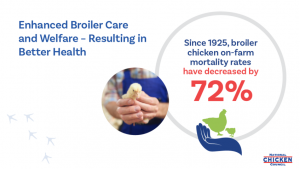NCC this week posted a blog on Chicken Check In, “How America’s chicken flock is healthier than ever before,” to highlight some of the broiler welfare stories that are featured in NCC’s 2020 Broiler Sustainability Report.
The original post can be found on Chicken Check In by clicking here.
“When our children aren’t feeling well, I make a little ‘treatment sheet,’ detailing when they receive medication, how much they are given, etc. The same goes for our birds,” said Rachel Rhodes, a chicken farmer in Maryland. “When our birds aren’t feeling well, we carefully monitor if they’re given a probiotic and how much they’re given, the amount of water they drink, and if they’re not as active. The health of our birds is just as important as the health of our children, because our birds are just like our children.”
The Rhodes family considers focusing 100% on the health and wellbeing of their birds their top priority as farmers, with the end goal of providing healthy, affordable food to consumers. But the Rhodes family is far from alone at putting chicken health and welfare first – the industry wouldn’t exist otherwise.
 Though animal health and welfare starts on the farm, the chicken industry significantly invests in innovation to keep improving animal husbandry. Most of all, the U.S. chicken industry has established ethical principles to ensure all birds are treated with respect, from the hatchery to the processing plant. The National Chicken Council (NCC) developed the NCC Animal Welfare Guidelines and Audit Checklist based upon the expertise of the World Organization for Animal Health. Good animal welfare constitutes chickens being healthy, comfortable, well-nourished, safe and not suffering from pain, fear or distress, along with essential guidelines.
Though animal health and welfare starts on the farm, the chicken industry significantly invests in innovation to keep improving animal husbandry. Most of all, the U.S. chicken industry has established ethical principles to ensure all birds are treated with respect, from the hatchery to the processing plant. The National Chicken Council (NCC) developed the NCC Animal Welfare Guidelines and Audit Checklist based upon the expertise of the World Organization for Animal Health. Good animal welfare constitutes chickens being healthy, comfortable, well-nourished, safe and not suffering from pain, fear or distress, along with essential guidelines.
To ensure new, science-based parameters are addressed, the NCC Broiler Welfare Guidelines are updated every 2 years. Such dedication helps explain why all current measurable data – livability, disease, condemnation, digestive and leg health – reflect the national broiler flock is healthier than ever before. Since 1925, broiler chicken on-farm mortality rates have decreased by 72%. In 2020, broiler chicken on-farm livability rates were 95%.
But the U.S. chicken industry remains committed to further enhancing broiler care. For decades, chicken producers have evolved on-farm care, transport, handling, processing and genetics to improve welfare outcomes while meeting ever-changing consumer preferences. Whether it’s looking at space and housing, studying different nutrition programs, breeding for the healthiest birds or working to eradicate diseases, the industry remains dedicated to continual improvement to do what is best for the bird, and ultimately, the consumer.
To learn more about how the U.S. chicken industry prioritizes broiler chicken health and welfare, view the complete inaugural sustainability report here.

